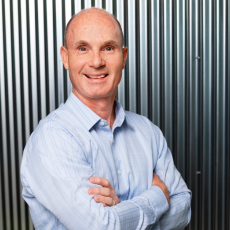In what context did McCain acquire TruLeaf and what made you decide to place your bets on vertical farming?
I have been working for McCain for 25 years all over the globe, and while back in the U.S., which led to my first encounter with TruLeaf. The synergies between the traditional agriculture practiced by McCain and the technology-based approach of TruLeaf facilitated the initial investment in April 2018. In every place I have lived in the world, from Japan to Singapore to Argentina, there is the sense that local is better, safer and more nutritious. This nationalism that goes along with food culture gives local supply chains a very significant impact on consumers. Somewhere between 80% and 90% of leafy greens in Canada are imported from the U.S., specifically from California and Arizona, where they are cultivated in open fields in extreme heat or cold and sprayed with pesticides, whether traditional crops or organic.
Until now, consumers have been conditioned to this suboptimal system where the produce has very little shelf life and low nutrient density. In addition to these, in a retail environment, the highest incident rate of recalls is in produce, and within produce it’s leafy greens, which can lead to food born illness. When you add these challenges to driver shortages and complicated cross-border supply chains, you arrive at the conclusion that vertical farms are vital for localized production. Retailers, restaurants and food service distributors have a hard time importing produce from thousands of kilometers away, so to have something local, available 365 days per year, and sustainable is absolutely business saving. Vertical farming is a capital-intensive venture, so the fact that we had the partners available to be able to build the infrastructure to do this properly made me push all my chips to the center of the table and say "I am in!"
Why are micro greens an important part of the food supply?

Micro greens have up to 40 times the nutritional density of mature plants and are more bioavailable. These specific characteristics allow us to create a new game changing segment within produce, especially from a health and nutrition perspective.
Sulforaphane, a compound found in micro broccoli, has been proven to have antitoxic and anti-inflammatory properties. As a result, some leading cancer institutes in the U.S. indicate that this compound could be responsible for mitigating certain elements of cancer.
When it comes to vertical farming, one of the biggest challenges is electricity prices. How are you trying to mitigate these hardships?
This issue has had a much bigger impact in Europe, due to energy spikes over the last year, than it had in our home market of Canada. Our facility in Quebec has clean hydroelectric energy at some of the lowest rates in North America, and the provincial government is very astutely looking at CEA as a strategic sector they want to support. Further out West, energy comes into the grid from traditional sources as well as from wind farms and solar panels. Energy is one component, but the overall carbon footprint is about 50% lower than the open field farmed product similar to ours. All these being said, we are currently collaborating with Canada's largest national retailers and we are selling at price parity to imports.
TruLeaf has entirely eliminated herbicides across crops. How are you going to isolate possible contaminants in the large facilities that you are deploying?
Thanks to our unique structural advantage, expressed through the fact that we are a food company, at core, we invested an enormous amount of time and money in thoroughly testing and benchmarking all nooks and crannies within our farms. We swab every single surface, and we test the water and the growing substrate before introducing it into the facilities, to make sure there are no pathogens. As a result, we have mitigated the concern of contaminants, but we always have to be ready for the what-ifs. Each of our stacks has its own irrigation and nutrient loop and, therefore, we can isolate them individually and not impact the rest of the farm. We have taken a deep look on how we engineer our future farms to make sure we are not only thinking about further expansion, but also about the pinnacle of food safety.
What role do you see technology playing in your future developments?
We spent a lot of time understanding where we need automation, and in some instances, we even took it out of the farms. The ultimate goal is to zero in on the optimum grow recipe and to, then, be able to replicate that day after day. Knowing, for example, which plants are growing next to each other is important because some transpire more than others, and create a microclimate with higher humidity. Our partnership with Microsoft, and other similar companies, helps us leverage sensor and imaging technologies that show in real time if the seed density is within the desired threshold. Technology helps us prepare everything for the surest possible cycle times and the highest yields with the most consistent quality.
What are the chief goals that you are looking towards in the next couple of years?
We have taken our time to understand the foundational imperatives of making vertical farming work, and, in what follows, we are pursuing operational excellence to know, with confidence, that we can operate at full capacity on a daily basis, and with the lowest labor input possible. Canadian retailers need somebody that can deliver across the country, and through our Montreal farm we serve Quebec and Atlantic Canada, the Ontario facility can service Ontario, and Calgary delivers to the Prairies and the West Coast. Based on this national footprint, ideally, in a few years, we will have 80% to 90% domestic production. By proving ourselves in Canada, we are beginning to attract interest from around the world, especially from geographies where the climate and the supply chains are challenging. Vertical farming offers the opportunity to take control of food sovereignty and this idea is going to resonate with many customers, and globally.






